Bournemouth University: Leadership Essay - Gender Blockage to Success
VerifiedAdded on 2023/05/31
|10
|2935
|180
Essay
AI Summary
This essay critically analyzes gender as a key blockage to leadership success within organizations. It explores the underrepresentation of women in leadership roles across various sectors like military, construction, and transportation, highlighting the persistent gender inequality. The essay identifies significant obstacles such as workplace harassment, the career-family dilemma, unconscious gender biases, and lack of support networks, which hinder women's advancement. It also provides practical recommendations for organizations, including implementing diversity policies that prohibit discrimination and harassment, promoting flexible work arrangements, and offering training and talent management programs tailored for women. Furthermore, it emphasizes the importance of government policies to enforce diversity and create a supportive environment where both male and female employees have equal opportunities for career growth. The essay concludes by reiterating the various gender-based obstacles that impede leadership success, emphasizing the need for comprehensive strategies to foster gender equality in leadership positions.
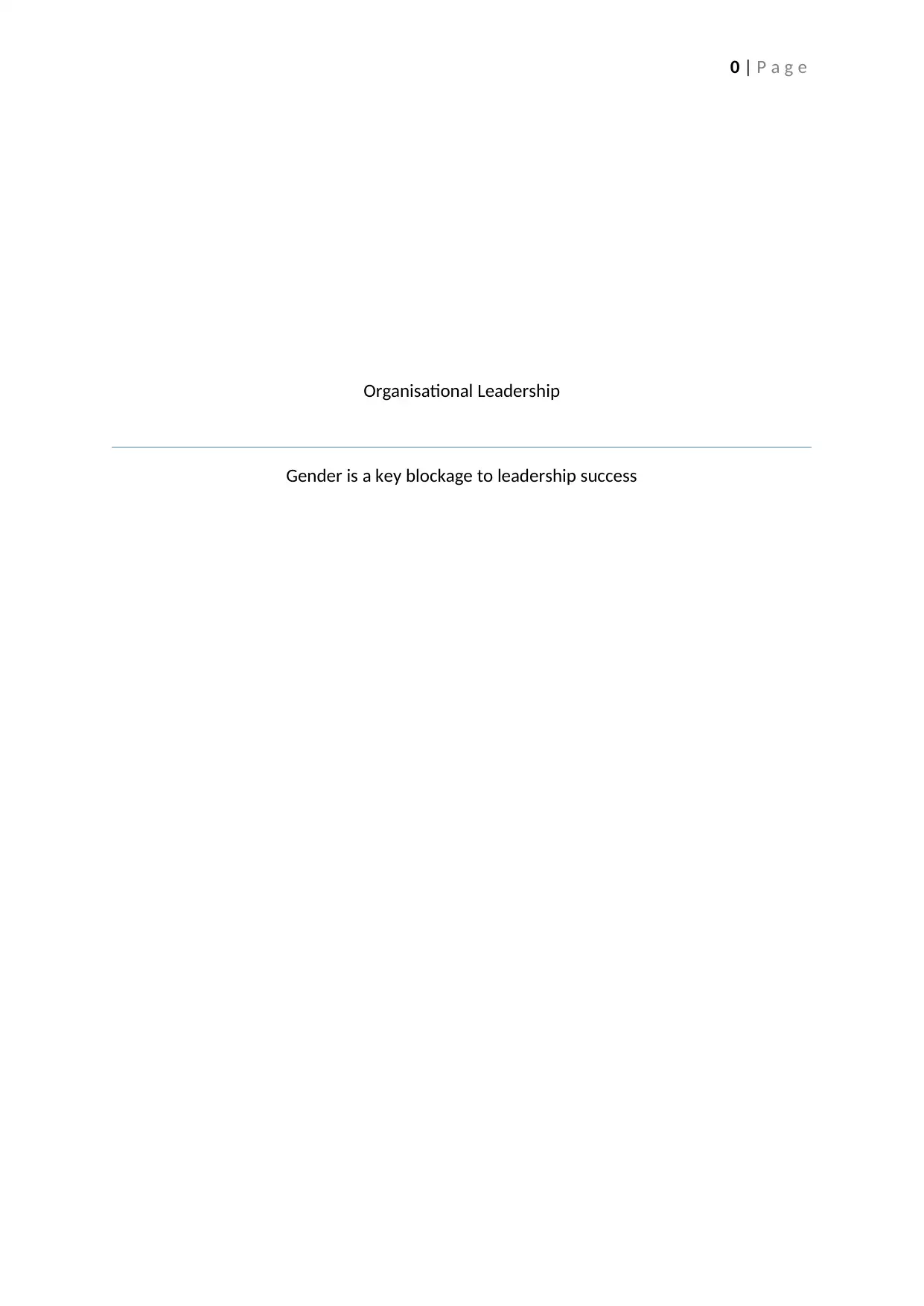
0 | P a g e
Organisational Leadership
Gender is a key blockage to leadership success
Organisational Leadership
Gender is a key blockage to leadership success
Paraphrase This Document
Need a fresh take? Get an instant paraphrase of this document with our AI Paraphraser
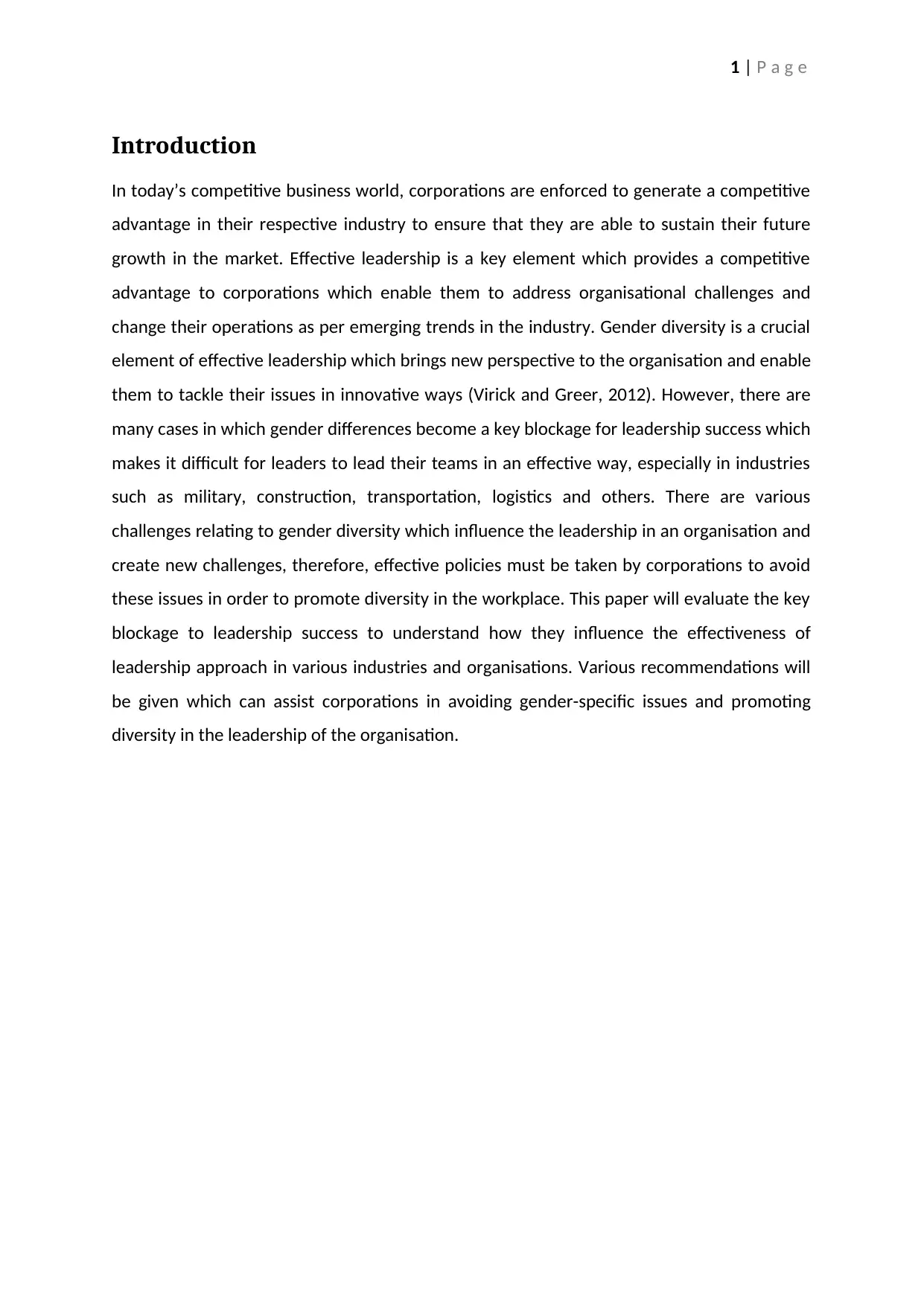
1 | P a g e
Introduction
In today’s competitive business world, corporations are enforced to generate a competitive
advantage in their respective industry to ensure that they are able to sustain their future
growth in the market. Effective leadership is a key element which provides a competitive
advantage to corporations which enable them to address organisational challenges and
change their operations as per emerging trends in the industry. Gender diversity is a crucial
element of effective leadership which brings new perspective to the organisation and enable
them to tackle their issues in innovative ways (Virick and Greer, 2012). However, there are
many cases in which gender differences become a key blockage for leadership success which
makes it difficult for leaders to lead their teams in an effective way, especially in industries
such as military, construction, transportation, logistics and others. There are various
challenges relating to gender diversity which influence the leadership in an organisation and
create new challenges, therefore, effective policies must be taken by corporations to avoid
these issues in order to promote diversity in the workplace. This paper will evaluate the key
blockage to leadership success to understand how they influence the effectiveness of
leadership approach in various industries and organisations. Various recommendations will
be given which can assist corporations in avoiding gender-specific issues and promoting
diversity in the leadership of the organisation.
Introduction
In today’s competitive business world, corporations are enforced to generate a competitive
advantage in their respective industry to ensure that they are able to sustain their future
growth in the market. Effective leadership is a key element which provides a competitive
advantage to corporations which enable them to address organisational challenges and
change their operations as per emerging trends in the industry. Gender diversity is a crucial
element of effective leadership which brings new perspective to the organisation and enable
them to tackle their issues in innovative ways (Virick and Greer, 2012). However, there are
many cases in which gender differences become a key blockage for leadership success which
makes it difficult for leaders to lead their teams in an effective way, especially in industries
such as military, construction, transportation, logistics and others. There are various
challenges relating to gender diversity which influence the leadership in an organisation and
create new challenges, therefore, effective policies must be taken by corporations to avoid
these issues in order to promote diversity in the workplace. This paper will evaluate the key
blockage to leadership success to understand how they influence the effectiveness of
leadership approach in various industries and organisations. Various recommendations will
be given which can assist corporations in avoiding gender-specific issues and promoting
diversity in the leadership of the organisation.
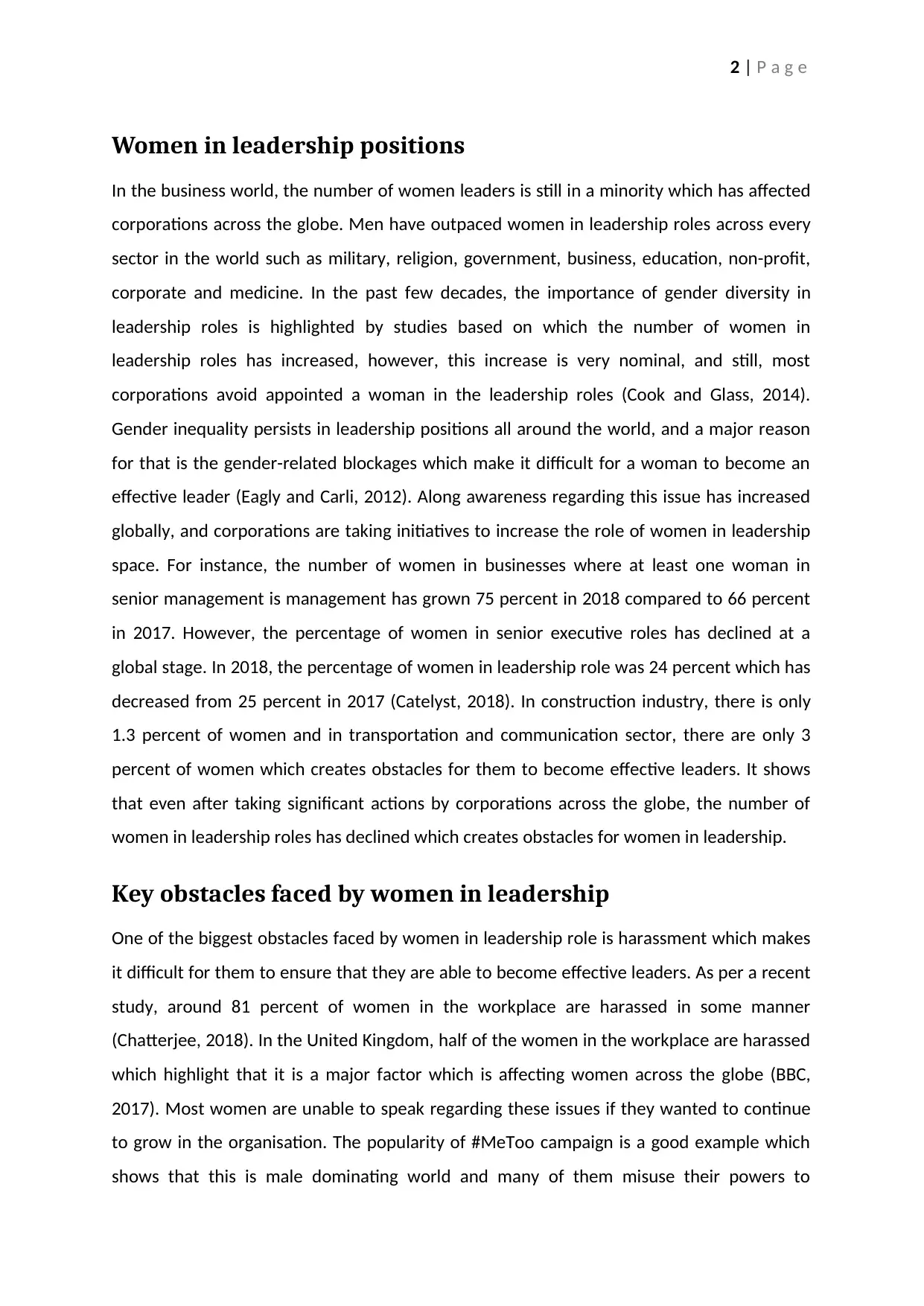
2 | P a g e
Women in leadership positions
In the business world, the number of women leaders is still in a minority which has affected
corporations across the globe. Men have outpaced women in leadership roles across every
sector in the world such as military, religion, government, business, education, non-profit,
corporate and medicine. In the past few decades, the importance of gender diversity in
leadership roles is highlighted by studies based on which the number of women in
leadership roles has increased, however, this increase is very nominal, and still, most
corporations avoid appointed a woman in the leadership roles (Cook and Glass, 2014).
Gender inequality persists in leadership positions all around the world, and a major reason
for that is the gender-related blockages which make it difficult for a woman to become an
effective leader (Eagly and Carli, 2012). Along awareness regarding this issue has increased
globally, and corporations are taking initiatives to increase the role of women in leadership
space. For instance, the number of women in businesses where at least one woman in
senior management is management has grown 75 percent in 2018 compared to 66 percent
in 2017. However, the percentage of women in senior executive roles has declined at a
global stage. In 2018, the percentage of women in leadership role was 24 percent which has
decreased from 25 percent in 2017 (Catelyst, 2018). In construction industry, there is only
1.3 percent of women and in transportation and communication sector, there are only 3
percent of women which creates obstacles for them to become effective leaders. It shows
that even after taking significant actions by corporations across the globe, the number of
women in leadership roles has declined which creates obstacles for women in leadership.
Key obstacles faced by women in leadership
One of the biggest obstacles faced by women in leadership role is harassment which makes
it difficult for them to ensure that they are able to become effective leaders. As per a recent
study, around 81 percent of women in the workplace are harassed in some manner
(Chatterjee, 2018). In the United Kingdom, half of the women in the workplace are harassed
which highlight that it is a major factor which is affecting women across the globe (BBC,
2017). Most women are unable to speak regarding these issues if they wanted to continue
to grow in the organisation. The popularity of #MeToo campaign is a good example which
shows that this is male dominating world and many of them misuse their powers to
Women in leadership positions
In the business world, the number of women leaders is still in a minority which has affected
corporations across the globe. Men have outpaced women in leadership roles across every
sector in the world such as military, religion, government, business, education, non-profit,
corporate and medicine. In the past few decades, the importance of gender diversity in
leadership roles is highlighted by studies based on which the number of women in
leadership roles has increased, however, this increase is very nominal, and still, most
corporations avoid appointed a woman in the leadership roles (Cook and Glass, 2014).
Gender inequality persists in leadership positions all around the world, and a major reason
for that is the gender-related blockages which make it difficult for a woman to become an
effective leader (Eagly and Carli, 2012). Along awareness regarding this issue has increased
globally, and corporations are taking initiatives to increase the role of women in leadership
space. For instance, the number of women in businesses where at least one woman in
senior management is management has grown 75 percent in 2018 compared to 66 percent
in 2017. However, the percentage of women in senior executive roles has declined at a
global stage. In 2018, the percentage of women in leadership role was 24 percent which has
decreased from 25 percent in 2017 (Catelyst, 2018). In construction industry, there is only
1.3 percent of women and in transportation and communication sector, there are only 3
percent of women which creates obstacles for them to become effective leaders. It shows
that even after taking significant actions by corporations across the globe, the number of
women in leadership roles has declined which creates obstacles for women in leadership.
Key obstacles faced by women in leadership
One of the biggest obstacles faced by women in leadership role is harassment which makes
it difficult for them to ensure that they are able to become effective leaders. As per a recent
study, around 81 percent of women in the workplace are harassed in some manner
(Chatterjee, 2018). In the United Kingdom, half of the women in the workplace are harassed
which highlight that it is a major factor which is affecting women across the globe (BBC,
2017). Most women are unable to speak regarding these issues if they wanted to continue
to grow in the organisation. The popularity of #MeToo campaign is a good example which
shows that this is male dominating world and many of them misuse their powers to
⊘ This is a preview!⊘
Do you want full access?
Subscribe today to unlock all pages.

Trusted by 1+ million students worldwide
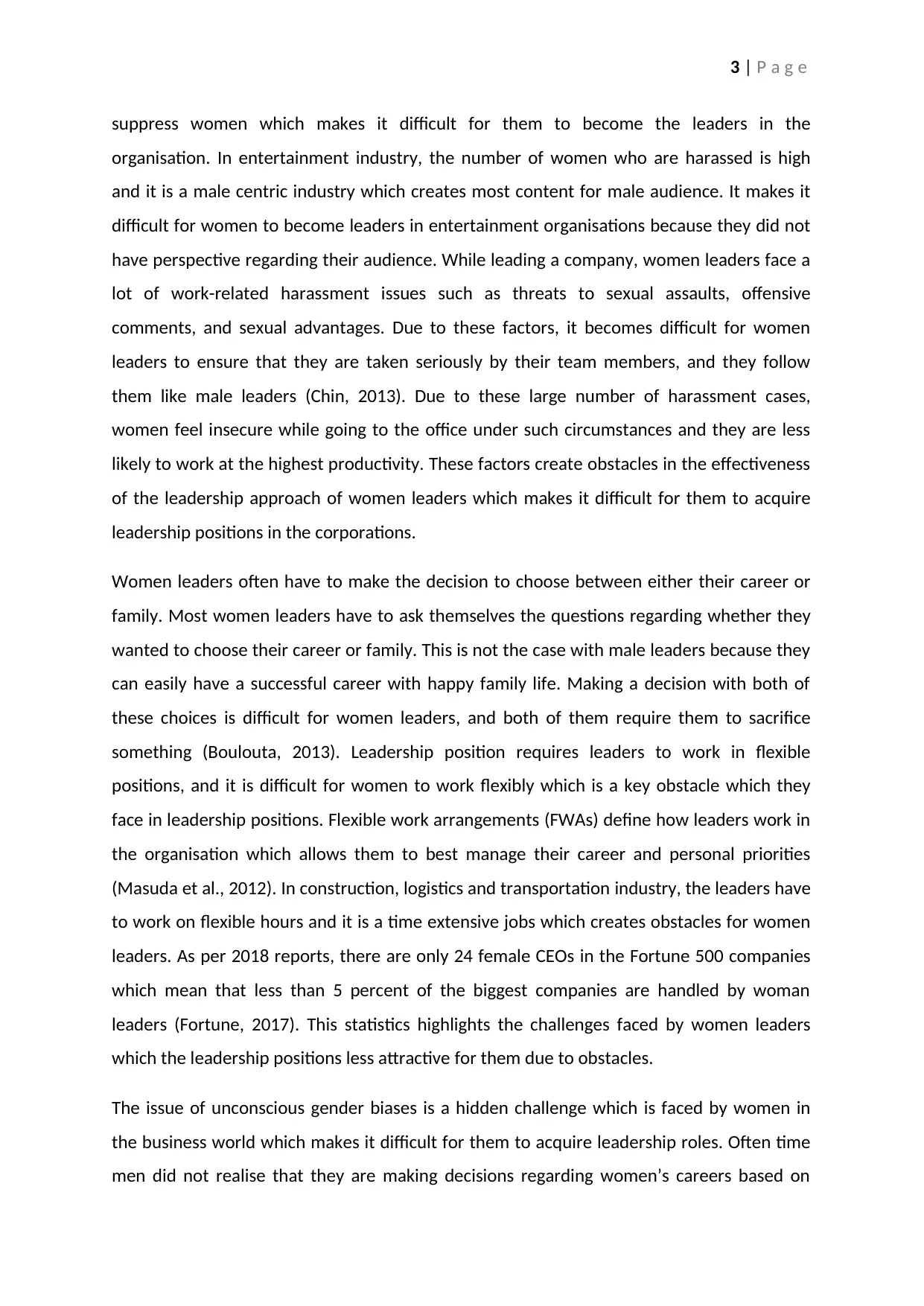
3 | P a g e
suppress women which makes it difficult for them to become the leaders in the
organisation. In entertainment industry, the number of women who are harassed is high
and it is a male centric industry which creates most content for male audience. It makes it
difficult for women to become leaders in entertainment organisations because they did not
have perspective regarding their audience. While leading a company, women leaders face a
lot of work-related harassment issues such as threats to sexual assaults, offensive
comments, and sexual advantages. Due to these factors, it becomes difficult for women
leaders to ensure that they are taken seriously by their team members, and they follow
them like male leaders (Chin, 2013). Due to these large number of harassment cases,
women feel insecure while going to the office under such circumstances and they are less
likely to work at the highest productivity. These factors create obstacles in the effectiveness
of the leadership approach of women leaders which makes it difficult for them to acquire
leadership positions in the corporations.
Women leaders often have to make the decision to choose between either their career or
family. Most women leaders have to ask themselves the questions regarding whether they
wanted to choose their career or family. This is not the case with male leaders because they
can easily have a successful career with happy family life. Making a decision with both of
these choices is difficult for women leaders, and both of them require them to sacrifice
something (Boulouta, 2013). Leadership position requires leaders to work in flexible
positions, and it is difficult for women to work flexibly which is a key obstacle which they
face in leadership positions. Flexible work arrangements (FWAs) define how leaders work in
the organisation which allows them to best manage their career and personal priorities
(Masuda et al., 2012). In construction, logistics and transportation industry, the leaders have
to work on flexible hours and it is a time extensive jobs which creates obstacles for women
leaders. As per 2018 reports, there are only 24 female CEOs in the Fortune 500 companies
which mean that less than 5 percent of the biggest companies are handled by woman
leaders (Fortune, 2017). This statistics highlights the challenges faced by women leaders
which the leadership positions less attractive for them due to obstacles.
The issue of unconscious gender biases is a hidden challenge which is faced by women in
the business world which makes it difficult for them to acquire leadership roles. Often time
men did not realise that they are making decisions regarding women’s careers based on
suppress women which makes it difficult for them to become the leaders in the
organisation. In entertainment industry, the number of women who are harassed is high
and it is a male centric industry which creates most content for male audience. It makes it
difficult for women to become leaders in entertainment organisations because they did not
have perspective regarding their audience. While leading a company, women leaders face a
lot of work-related harassment issues such as threats to sexual assaults, offensive
comments, and sexual advantages. Due to these factors, it becomes difficult for women
leaders to ensure that they are taken seriously by their team members, and they follow
them like male leaders (Chin, 2013). Due to these large number of harassment cases,
women feel insecure while going to the office under such circumstances and they are less
likely to work at the highest productivity. These factors create obstacles in the effectiveness
of the leadership approach of women leaders which makes it difficult for them to acquire
leadership positions in the corporations.
Women leaders often have to make the decision to choose between either their career or
family. Most women leaders have to ask themselves the questions regarding whether they
wanted to choose their career or family. This is not the case with male leaders because they
can easily have a successful career with happy family life. Making a decision with both of
these choices is difficult for women leaders, and both of them require them to sacrifice
something (Boulouta, 2013). Leadership position requires leaders to work in flexible
positions, and it is difficult for women to work flexibly which is a key obstacle which they
face in leadership positions. Flexible work arrangements (FWAs) define how leaders work in
the organisation which allows them to best manage their career and personal priorities
(Masuda et al., 2012). In construction, logistics and transportation industry, the leaders have
to work on flexible hours and it is a time extensive jobs which creates obstacles for women
leaders. As per 2018 reports, there are only 24 female CEOs in the Fortune 500 companies
which mean that less than 5 percent of the biggest companies are handled by woman
leaders (Fortune, 2017). This statistics highlights the challenges faced by women leaders
which the leadership positions less attractive for them due to obstacles.
The issue of unconscious gender biases is a hidden challenge which is faced by women in
the business world which makes it difficult for them to acquire leadership roles. Often time
men did not realise that they are making decisions regarding women’s careers based on
Paraphrase This Document
Need a fresh take? Get an instant paraphrase of this document with our AI Paraphraser
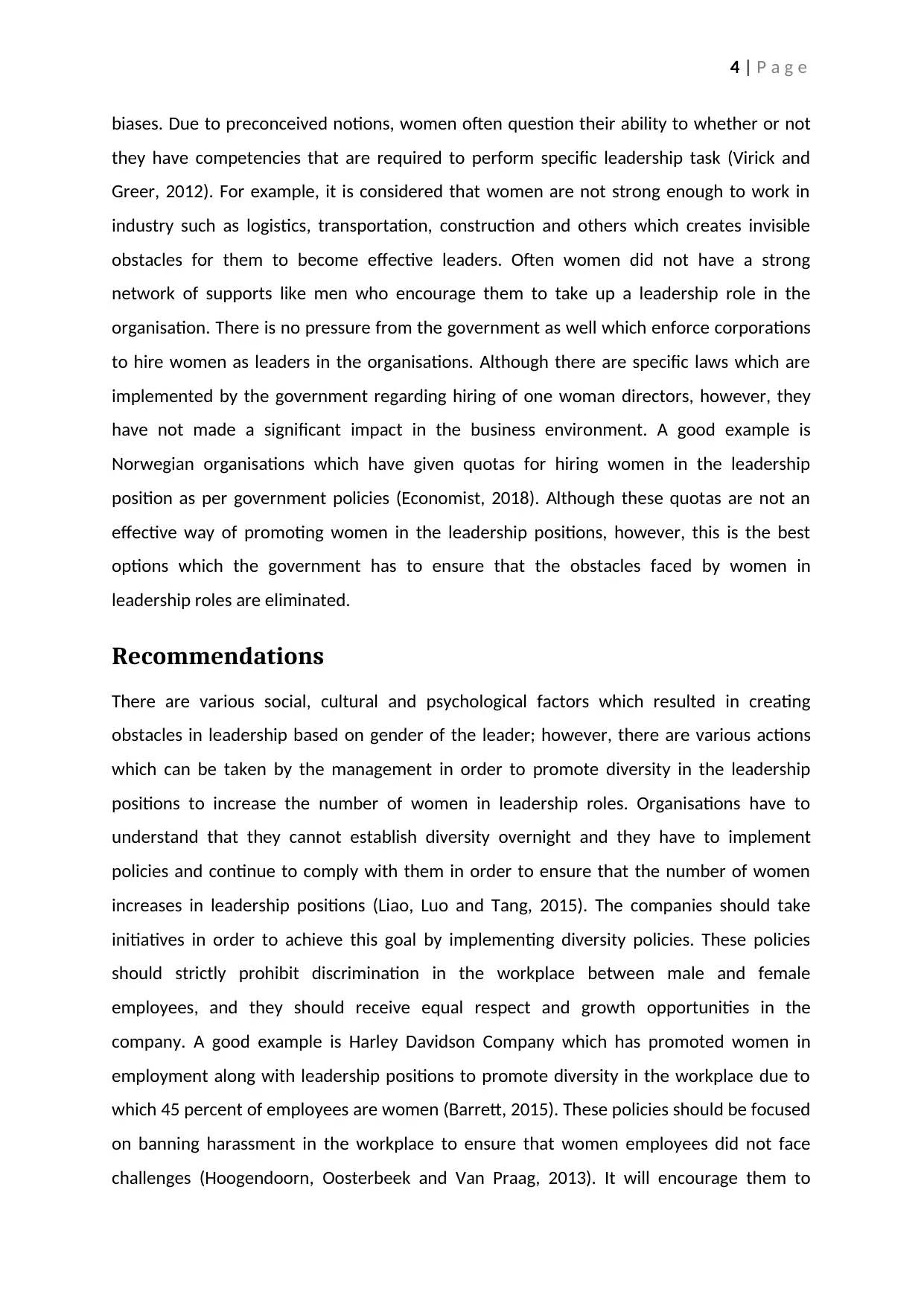
4 | P a g e
biases. Due to preconceived notions, women often question their ability to whether or not
they have competencies that are required to perform specific leadership task (Virick and
Greer, 2012). For example, it is considered that women are not strong enough to work in
industry such as logistics, transportation, construction and others which creates invisible
obstacles for them to become effective leaders. Often women did not have a strong
network of supports like men who encourage them to take up a leadership role in the
organisation. There is no pressure from the government as well which enforce corporations
to hire women as leaders in the organisations. Although there are specific laws which are
implemented by the government regarding hiring of one woman directors, however, they
have not made a significant impact in the business environment. A good example is
Norwegian organisations which have given quotas for hiring women in the leadership
position as per government policies (Economist, 2018). Although these quotas are not an
effective way of promoting women in the leadership positions, however, this is the best
options which the government has to ensure that the obstacles faced by women in
leadership roles are eliminated.
Recommendations
There are various social, cultural and psychological factors which resulted in creating
obstacles in leadership based on gender of the leader; however, there are various actions
which can be taken by the management in order to promote diversity in the leadership
positions to increase the number of women in leadership roles. Organisations have to
understand that they cannot establish diversity overnight and they have to implement
policies and continue to comply with them in order to ensure that the number of women
increases in leadership positions (Liao, Luo and Tang, 2015). The companies should take
initiatives in order to achieve this goal by implementing diversity policies. These policies
should strictly prohibit discrimination in the workplace between male and female
employees, and they should receive equal respect and growth opportunities in the
company. A good example is Harley Davidson Company which has promoted women in
employment along with leadership positions to promote diversity in the workplace due to
which 45 percent of employees are women (Barrett, 2015). These policies should be focused
on banning harassment in the workplace to ensure that women employees did not face
challenges (Hoogendoorn, Oosterbeek and Van Praag, 2013). It will encourage them to
biases. Due to preconceived notions, women often question their ability to whether or not
they have competencies that are required to perform specific leadership task (Virick and
Greer, 2012). For example, it is considered that women are not strong enough to work in
industry such as logistics, transportation, construction and others which creates invisible
obstacles for them to become effective leaders. Often women did not have a strong
network of supports like men who encourage them to take up a leadership role in the
organisation. There is no pressure from the government as well which enforce corporations
to hire women as leaders in the organisations. Although there are specific laws which are
implemented by the government regarding hiring of one woman directors, however, they
have not made a significant impact in the business environment. A good example is
Norwegian organisations which have given quotas for hiring women in the leadership
position as per government policies (Economist, 2018). Although these quotas are not an
effective way of promoting women in the leadership positions, however, this is the best
options which the government has to ensure that the obstacles faced by women in
leadership roles are eliminated.
Recommendations
There are various social, cultural and psychological factors which resulted in creating
obstacles in leadership based on gender of the leader; however, there are various actions
which can be taken by the management in order to promote diversity in the leadership
positions to increase the number of women in leadership roles. Organisations have to
understand that they cannot establish diversity overnight and they have to implement
policies and continue to comply with them in order to ensure that the number of women
increases in leadership positions (Liao, Luo and Tang, 2015). The companies should take
initiatives in order to achieve this goal by implementing diversity policies. These policies
should strictly prohibit discrimination in the workplace between male and female
employees, and they should receive equal respect and growth opportunities in the
company. A good example is Harley Davidson Company which has promoted women in
employment along with leadership positions to promote diversity in the workplace due to
which 45 percent of employees are women (Barrett, 2015). These policies should be focused
on banning harassment in the workplace to ensure that women employees did not face
challenges (Hoogendoorn, Oosterbeek and Van Praag, 2013). It will encourage them to
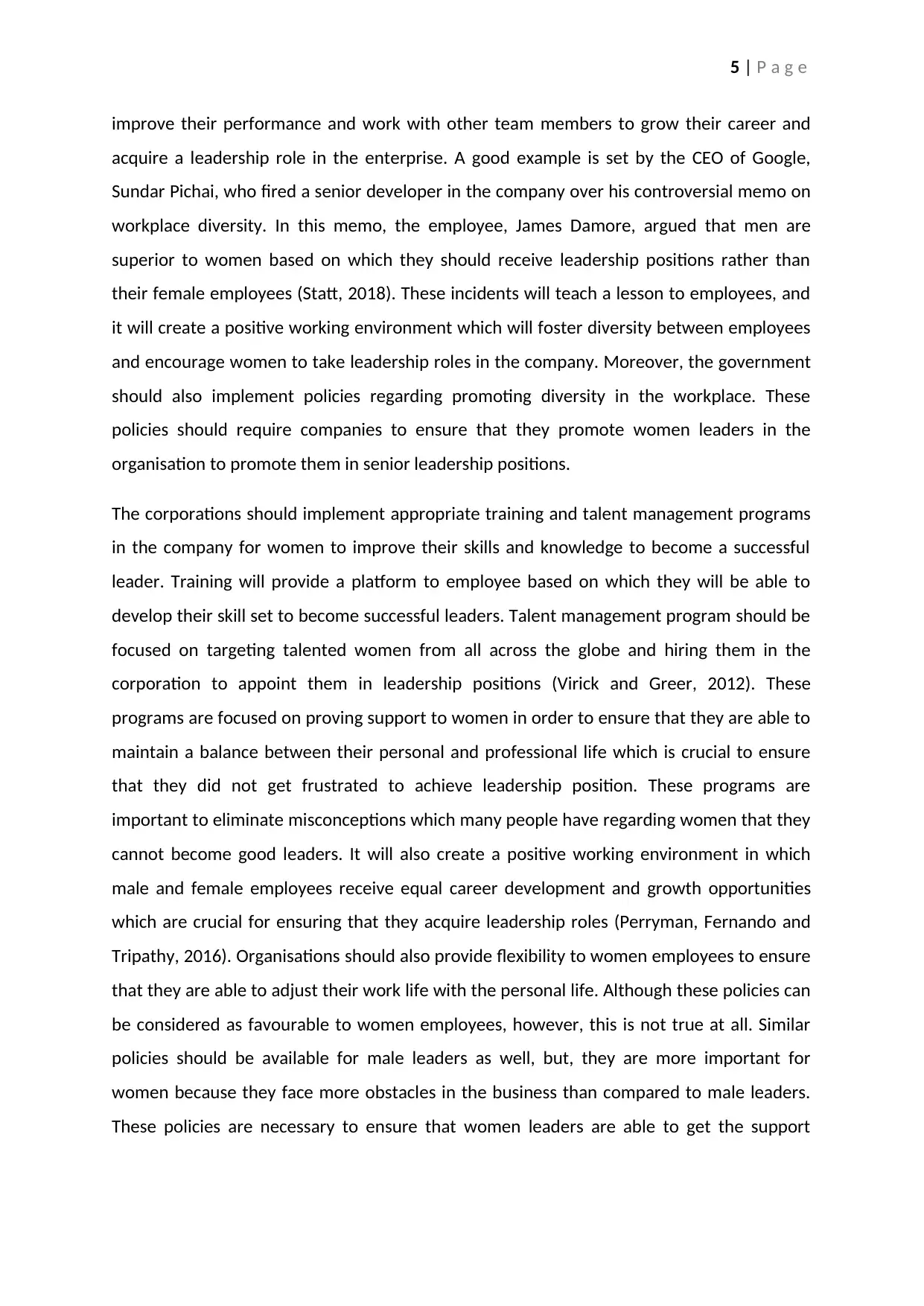
5 | P a g e
improve their performance and work with other team members to grow their career and
acquire a leadership role in the enterprise. A good example is set by the CEO of Google,
Sundar Pichai, who fired a senior developer in the company over his controversial memo on
workplace diversity. In this memo, the employee, James Damore, argued that men are
superior to women based on which they should receive leadership positions rather than
their female employees (Statt, 2018). These incidents will teach a lesson to employees, and
it will create a positive working environment which will foster diversity between employees
and encourage women to take leadership roles in the company. Moreover, the government
should also implement policies regarding promoting diversity in the workplace. These
policies should require companies to ensure that they promote women leaders in the
organisation to promote them in senior leadership positions.
The corporations should implement appropriate training and talent management programs
in the company for women to improve their skills and knowledge to become a successful
leader. Training will provide a platform to employee based on which they will be able to
develop their skill set to become successful leaders. Talent management program should be
focused on targeting talented women from all across the globe and hiring them in the
corporation to appoint them in leadership positions (Virick and Greer, 2012). These
programs are focused on proving support to women in order to ensure that they are able to
maintain a balance between their personal and professional life which is crucial to ensure
that they did not get frustrated to achieve leadership position. These programs are
important to eliminate misconceptions which many people have regarding women that they
cannot become good leaders. It will also create a positive working environment in which
male and female employees receive equal career development and growth opportunities
which are crucial for ensuring that they acquire leadership roles (Perryman, Fernando and
Tripathy, 2016). Organisations should also provide flexibility to women employees to ensure
that they are able to adjust their work life with the personal life. Although these policies can
be considered as favourable to women employees, however, this is not true at all. Similar
policies should be available for male leaders as well, but, they are more important for
women because they face more obstacles in the business than compared to male leaders.
These policies are necessary to ensure that women leaders are able to get the support
improve their performance and work with other team members to grow their career and
acquire a leadership role in the enterprise. A good example is set by the CEO of Google,
Sundar Pichai, who fired a senior developer in the company over his controversial memo on
workplace diversity. In this memo, the employee, James Damore, argued that men are
superior to women based on which they should receive leadership positions rather than
their female employees (Statt, 2018). These incidents will teach a lesson to employees, and
it will create a positive working environment which will foster diversity between employees
and encourage women to take leadership roles in the company. Moreover, the government
should also implement policies regarding promoting diversity in the workplace. These
policies should require companies to ensure that they promote women leaders in the
organisation to promote them in senior leadership positions.
The corporations should implement appropriate training and talent management programs
in the company for women to improve their skills and knowledge to become a successful
leader. Training will provide a platform to employee based on which they will be able to
develop their skill set to become successful leaders. Talent management program should be
focused on targeting talented women from all across the globe and hiring them in the
corporation to appoint them in leadership positions (Virick and Greer, 2012). These
programs are focused on proving support to women in order to ensure that they are able to
maintain a balance between their personal and professional life which is crucial to ensure
that they did not get frustrated to achieve leadership position. These programs are
important to eliminate misconceptions which many people have regarding women that they
cannot become good leaders. It will also create a positive working environment in which
male and female employees receive equal career development and growth opportunities
which are crucial for ensuring that they acquire leadership roles (Perryman, Fernando and
Tripathy, 2016). Organisations should also provide flexibility to women employees to ensure
that they are able to adjust their work life with the personal life. Although these policies can
be considered as favourable to women employees, however, this is not true at all. Similar
policies should be available for male leaders as well, but, they are more important for
women because they face more obstacles in the business than compared to male leaders.
These policies are necessary to ensure that women leaders are able to get the support
⊘ This is a preview!⊘
Do you want full access?
Subscribe today to unlock all pages.

Trusted by 1+ million students worldwide
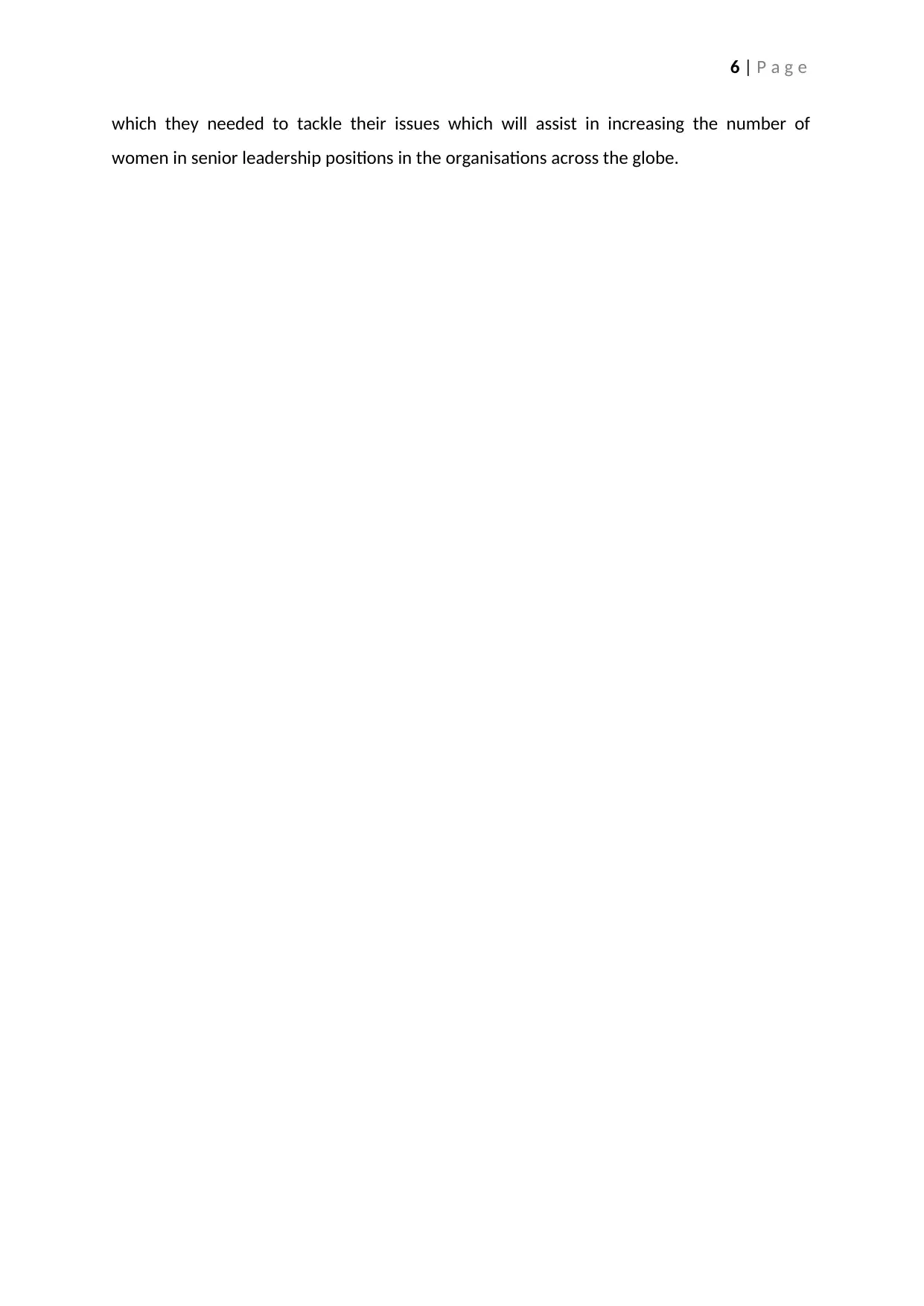
6 | P a g e
which they needed to tackle their issues which will assist in increasing the number of
women in senior leadership positions in the organisations across the globe.
which they needed to tackle their issues which will assist in increasing the number of
women in senior leadership positions in the organisations across the globe.
Paraphrase This Document
Need a fresh take? Get an instant paraphrase of this document with our AI Paraphraser
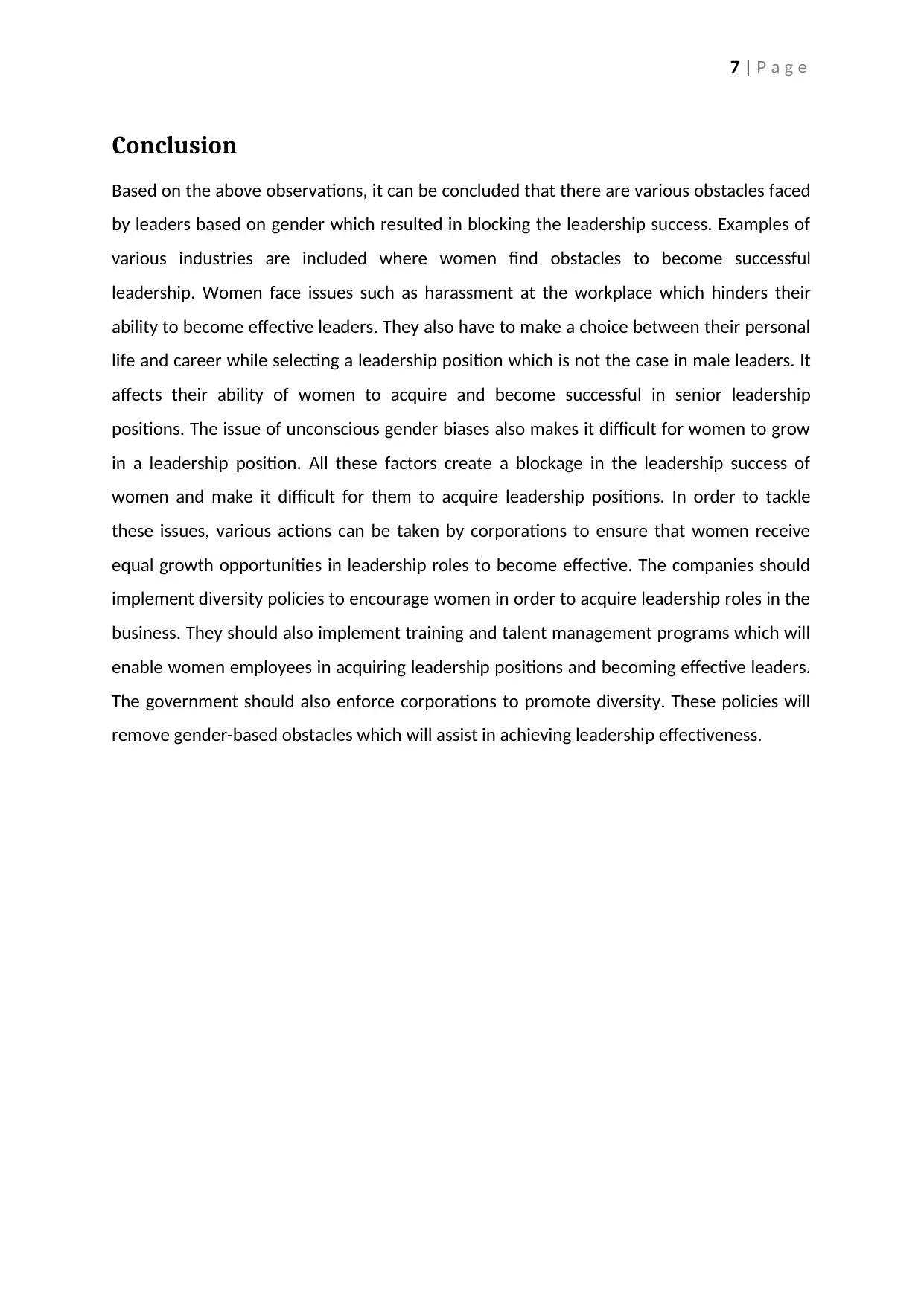
7 | P a g e
Conclusion
Based on the above observations, it can be concluded that there are various obstacles faced
by leaders based on gender which resulted in blocking the leadership success. Examples of
various industries are included where women find obstacles to become successful
leadership. Women face issues such as harassment at the workplace which hinders their
ability to become effective leaders. They also have to make a choice between their personal
life and career while selecting a leadership position which is not the case in male leaders. It
affects their ability of women to acquire and become successful in senior leadership
positions. The issue of unconscious gender biases also makes it difficult for women to grow
in a leadership position. All these factors create a blockage in the leadership success of
women and make it difficult for them to acquire leadership positions. In order to tackle
these issues, various actions can be taken by corporations to ensure that women receive
equal growth opportunities in leadership roles to become effective. The companies should
implement diversity policies to encourage women in order to acquire leadership roles in the
business. They should also implement training and talent management programs which will
enable women employees in acquiring leadership positions and becoming effective leaders.
The government should also enforce corporations to promote diversity. These policies will
remove gender-based obstacles which will assist in achieving leadership effectiveness.
Conclusion
Based on the above observations, it can be concluded that there are various obstacles faced
by leaders based on gender which resulted in blocking the leadership success. Examples of
various industries are included where women find obstacles to become successful
leadership. Women face issues such as harassment at the workplace which hinders their
ability to become effective leaders. They also have to make a choice between their personal
life and career while selecting a leadership position which is not the case in male leaders. It
affects their ability of women to acquire and become successful in senior leadership
positions. The issue of unconscious gender biases also makes it difficult for women to grow
in a leadership position. All these factors create a blockage in the leadership success of
women and make it difficult for them to acquire leadership positions. In order to tackle
these issues, various actions can be taken by corporations to ensure that women receive
equal growth opportunities in leadership roles to become effective. The companies should
implement diversity policies to encourage women in order to acquire leadership roles in the
business. They should also implement training and talent management programs which will
enable women employees in acquiring leadership positions and becoming effective leaders.
The government should also enforce corporations to promote diversity. These policies will
remove gender-based obstacles which will assist in achieving leadership effectiveness.
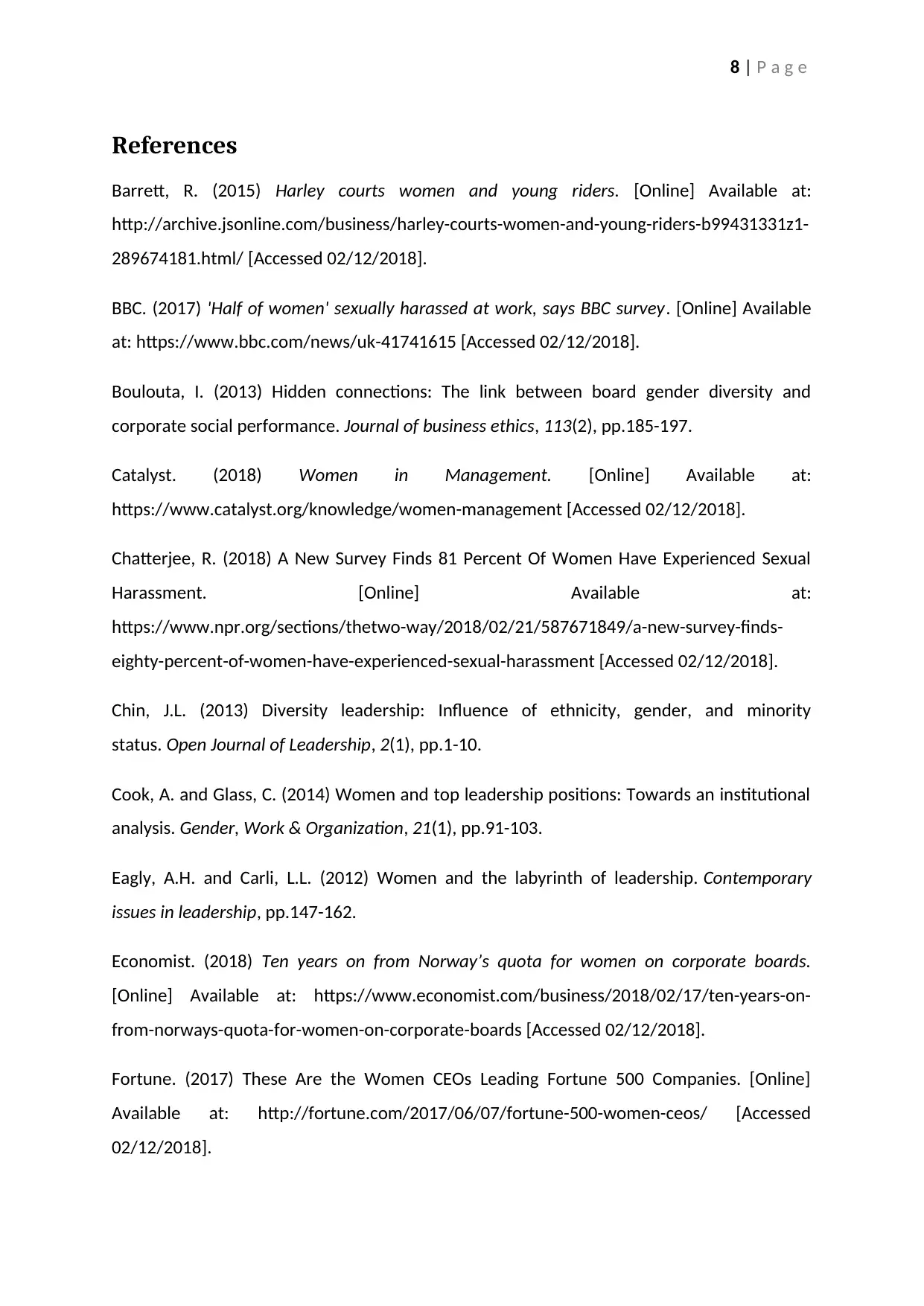
8 | P a g e
References
Barrett, R. (2015) Harley courts women and young riders. [Online] Available at:
http://archive.jsonline.com/business/harley-courts-women-and-young-riders-b99431331z1-
289674181.html/ [Accessed 02/12/2018].
BBC. (2017) 'Half of women' sexually harassed at work, says BBC survey. [Online] Available
at: https://www.bbc.com/news/uk-41741615 [Accessed 02/12/2018].
Boulouta, I. (2013) Hidden connections: The link between board gender diversity and
corporate social performance. Journal of business ethics, 113(2), pp.185-197.
Catalyst. (2018) Women in Management. [Online] Available at:
https://www.catalyst.org/knowledge/women-management [Accessed 02/12/2018].
Chatterjee, R. (2018) A New Survey Finds 81 Percent Of Women Have Experienced Sexual
Harassment. [Online] Available at:
https://www.npr.org/sections/thetwo-way/2018/02/21/587671849/a-new-survey-finds-
eighty-percent-of-women-have-experienced-sexual-harassment [Accessed 02/12/2018].
Chin, J.L. (2013) Diversity leadership: Influence of ethnicity, gender, and minority
status. Open Journal of Leadership, 2(1), pp.1-10.
Cook, A. and Glass, C. (2014) Women and top leadership positions: Towards an institutional
analysis. Gender, Work & Organization, 21(1), pp.91-103.
Eagly, A.H. and Carli, L.L. (2012) Women and the labyrinth of leadership. Contemporary
issues in leadership, pp.147-162.
Economist. (2018) Ten years on from Norway’s quota for women on corporate boards.
[Online] Available at: https://www.economist.com/business/2018/02/17/ten-years-on-
from-norways-quota-for-women-on-corporate-boards [Accessed 02/12/2018].
Fortune. (2017) These Are the Women CEOs Leading Fortune 500 Companies. [Online]
Available at: http://fortune.com/2017/06/07/fortune-500-women-ceos/ [Accessed
02/12/2018].
References
Barrett, R. (2015) Harley courts women and young riders. [Online] Available at:
http://archive.jsonline.com/business/harley-courts-women-and-young-riders-b99431331z1-
289674181.html/ [Accessed 02/12/2018].
BBC. (2017) 'Half of women' sexually harassed at work, says BBC survey. [Online] Available
at: https://www.bbc.com/news/uk-41741615 [Accessed 02/12/2018].
Boulouta, I. (2013) Hidden connections: The link between board gender diversity and
corporate social performance. Journal of business ethics, 113(2), pp.185-197.
Catalyst. (2018) Women in Management. [Online] Available at:
https://www.catalyst.org/knowledge/women-management [Accessed 02/12/2018].
Chatterjee, R. (2018) A New Survey Finds 81 Percent Of Women Have Experienced Sexual
Harassment. [Online] Available at:
https://www.npr.org/sections/thetwo-way/2018/02/21/587671849/a-new-survey-finds-
eighty-percent-of-women-have-experienced-sexual-harassment [Accessed 02/12/2018].
Chin, J.L. (2013) Diversity leadership: Influence of ethnicity, gender, and minority
status. Open Journal of Leadership, 2(1), pp.1-10.
Cook, A. and Glass, C. (2014) Women and top leadership positions: Towards an institutional
analysis. Gender, Work & Organization, 21(1), pp.91-103.
Eagly, A.H. and Carli, L.L. (2012) Women and the labyrinth of leadership. Contemporary
issues in leadership, pp.147-162.
Economist. (2018) Ten years on from Norway’s quota for women on corporate boards.
[Online] Available at: https://www.economist.com/business/2018/02/17/ten-years-on-
from-norways-quota-for-women-on-corporate-boards [Accessed 02/12/2018].
Fortune. (2017) These Are the Women CEOs Leading Fortune 500 Companies. [Online]
Available at: http://fortune.com/2017/06/07/fortune-500-women-ceos/ [Accessed
02/12/2018].
⊘ This is a preview!⊘
Do you want full access?
Subscribe today to unlock all pages.

Trusted by 1+ million students worldwide
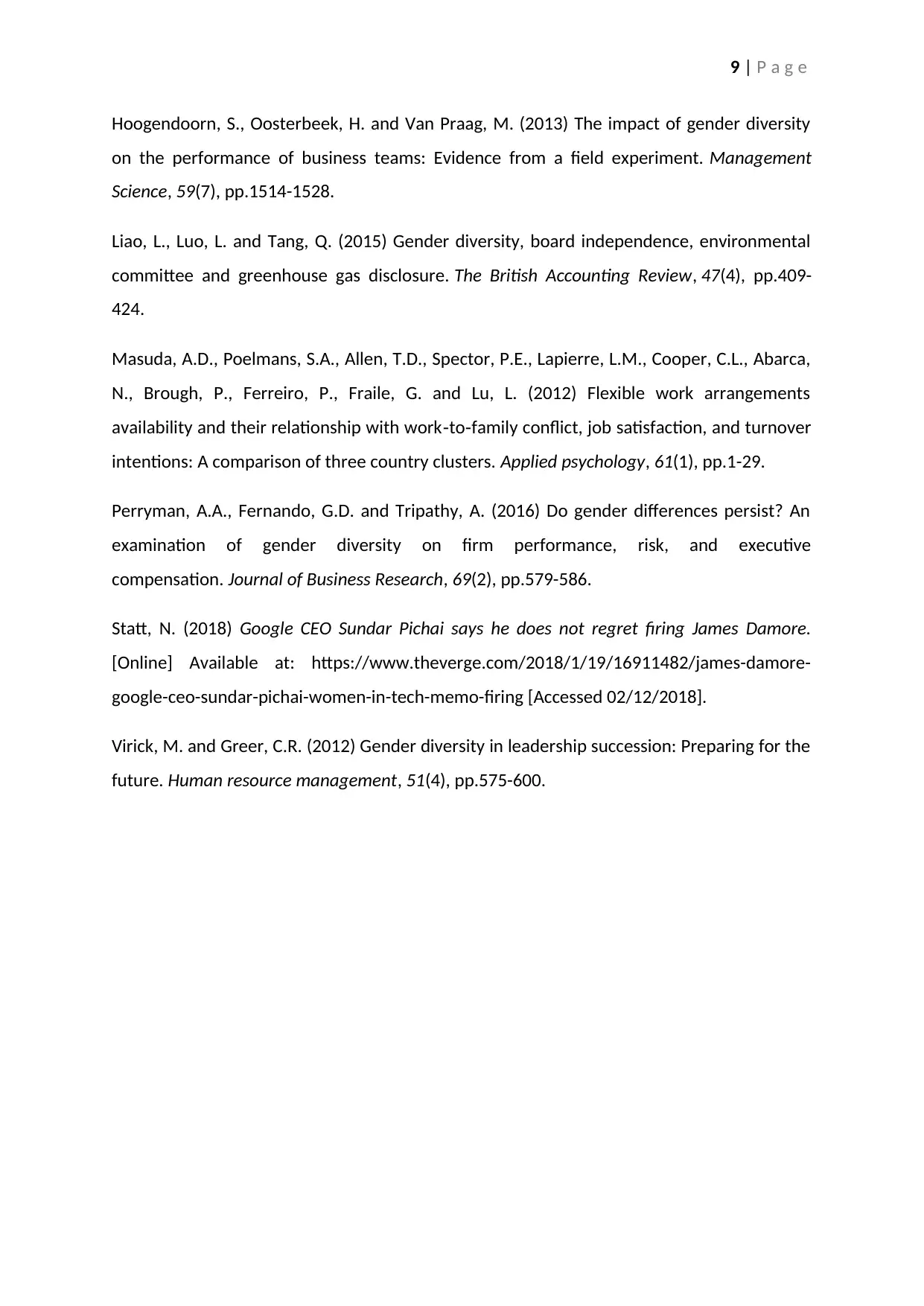
9 | P a g e
Hoogendoorn, S., Oosterbeek, H. and Van Praag, M. (2013) The impact of gender diversity
on the performance of business teams: Evidence from a field experiment. Management
Science, 59(7), pp.1514-1528.
Liao, L., Luo, L. and Tang, Q. (2015) Gender diversity, board independence, environmental
committee and greenhouse gas disclosure. The British Accounting Review, 47(4), pp.409-
424.
Masuda, A.D., Poelmans, S.A., Allen, T.D., Spector, P.E., Lapierre, L.M., Cooper, C.L., Abarca,
N., Brough, P., Ferreiro, P., Fraile, G. and Lu, L. (2012) Flexible work arrangements
availability and their relationship with work‐to‐family conflict, job satisfaction, and turnover
intentions: A comparison of three country clusters. Applied psychology, 61(1), pp.1-29.
Perryman, A.A., Fernando, G.D. and Tripathy, A. (2016) Do gender differences persist? An
examination of gender diversity on firm performance, risk, and executive
compensation. Journal of Business Research, 69(2), pp.579-586.
Statt, N. (2018) Google CEO Sundar Pichai says he does not regret firing James Damore.
[Online] Available at: https://www.theverge.com/2018/1/19/16911482/james-damore-
google-ceo-sundar-pichai-women-in-tech-memo-firing [Accessed 02/12/2018].
Virick, M. and Greer, C.R. (2012) Gender diversity in leadership succession: Preparing for the
future. Human resource management, 51(4), pp.575-600.
Hoogendoorn, S., Oosterbeek, H. and Van Praag, M. (2013) The impact of gender diversity
on the performance of business teams: Evidence from a field experiment. Management
Science, 59(7), pp.1514-1528.
Liao, L., Luo, L. and Tang, Q. (2015) Gender diversity, board independence, environmental
committee and greenhouse gas disclosure. The British Accounting Review, 47(4), pp.409-
424.
Masuda, A.D., Poelmans, S.A., Allen, T.D., Spector, P.E., Lapierre, L.M., Cooper, C.L., Abarca,
N., Brough, P., Ferreiro, P., Fraile, G. and Lu, L. (2012) Flexible work arrangements
availability and their relationship with work‐to‐family conflict, job satisfaction, and turnover
intentions: A comparison of three country clusters. Applied psychology, 61(1), pp.1-29.
Perryman, A.A., Fernando, G.D. and Tripathy, A. (2016) Do gender differences persist? An
examination of gender diversity on firm performance, risk, and executive
compensation. Journal of Business Research, 69(2), pp.579-586.
Statt, N. (2018) Google CEO Sundar Pichai says he does not regret firing James Damore.
[Online] Available at: https://www.theverge.com/2018/1/19/16911482/james-damore-
google-ceo-sundar-pichai-women-in-tech-memo-firing [Accessed 02/12/2018].
Virick, M. and Greer, C.R. (2012) Gender diversity in leadership succession: Preparing for the
future. Human resource management, 51(4), pp.575-600.
1 out of 10
Related Documents
Your All-in-One AI-Powered Toolkit for Academic Success.
+13062052269
info@desklib.com
Available 24*7 on WhatsApp / Email
![[object Object]](/_next/static/media/star-bottom.7253800d.svg)
Unlock your academic potential
Copyright © 2020–2025 A2Z Services. All Rights Reserved. Developed and managed by ZUCOL.





